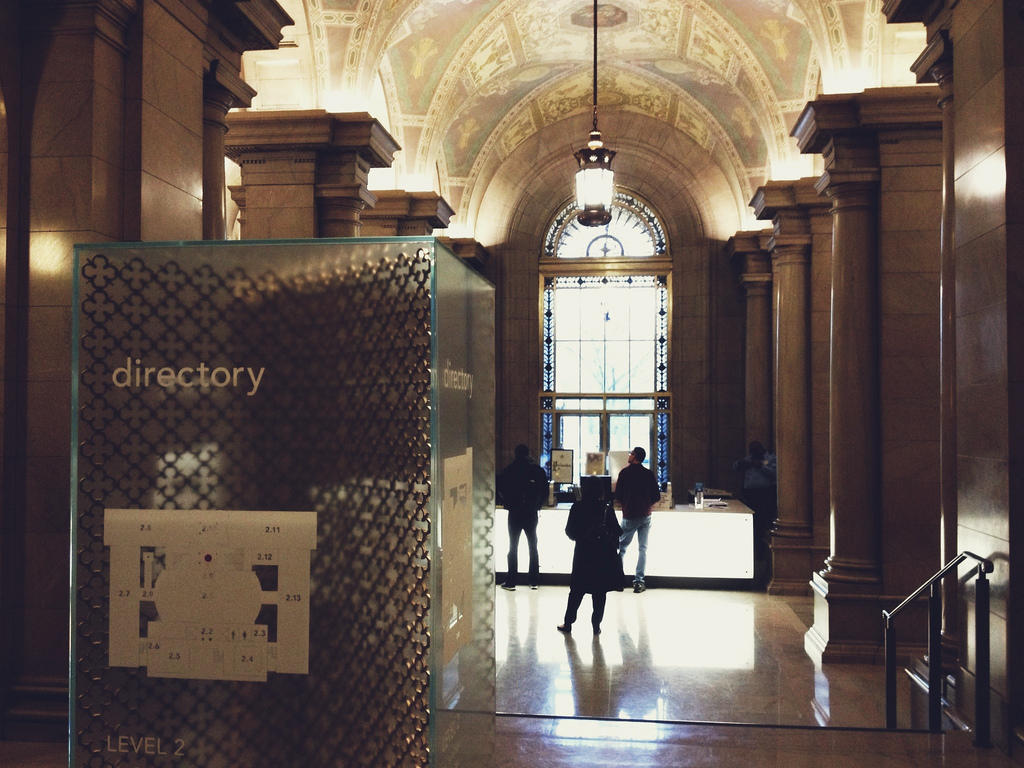The first change I noticed upon entering the SLPL’s newly renovated Central Library was the addition of light. The centerpiece of the project is a gleaming new three-story atrium at the building’s north entrance, but the team responsible has also done a remarkable job of adding new sources of light to some of the oldest parts of the library, without drastically altering the original — historic — structure. Remote-controlled window panels allow for easy adjustments in natural light, and the stacks and study tables are now tastefully accented with LED strips that give the older spaces the feel of a cleaner, brighter Blade Runner.
Changes are coming to library programming and services, too, taking full advantage of the spatial and technological advances afforded by the renovations. Later this month a weekly film series will introduce patrons to the new auditorium on the library’s lower level, and iPads are now available to carry around the wifi-enabled halls, mitigating the need to constantly seek out a terminal to locate something in the collection.
I was further impressed by how little grandstanding and back-patting could be be found; apart from a few panels outlining the atrium construction, I saw no signs boasting about the scope and success of the renovation. The number of people using the library on the afternoon of my visit was a stronger indication of success than any poster would have been.
But as I read about the launch of book-free libraries and consider the changing expectations of patrons, I have to wonder if the “new” Central is really designed for the future or just a more efficient present.
At the heart of the library’s fully reimagined ground level is something called the Center for the Reader. It wasn’t hard for me to figure out its purpose. Literary quotes float over visitors’ heads. Partially enclosed circular nooks offer readers the seclusion of a back corner while keeping them close to the collection and the on-site librarian in case they have questions or are ready to take home what they’ve been reading. For the casual reader or neighborhood resident, it seems like an ideal space; a place to browse the latest fiction releases or quickly grab books on hold on your way to or from another destination. But should this really be the focus for a library of this scale? And if so, why was the Center for the Reader the least-populated room in the library?
In contrast, the computer banks and cafe spaces of the atrium were hives of activity throughout my afternoon visit, with more reading happening at each single desk or table than the whole of the Center for the Reader. While internet users were tethered to their terminals, any of the cafe area patrons could have claimed his or her own table in the Center for the Reader, but they seemed more comfortable crowded together with other patrons. Why?
Seth Godin calls the library of the future “a place where people come together to do co-working and coordinate and invent projects worth working on together…”
The next library is filled with so many web terminals there’s always at least one empty. And the people who run this library don’t view the combination of access to data and connections to peers as a sidelight—it’s the entire point.
Wouldn’t you want to live and work and pay taxes in a town that had a library like that? The vibe of the best Brooklyn coffee shop combined with a passionate raconteur of information?
Pockets of Central reflect this notion, yet despite the near-doubling of public space accomplished through its renovation, the library’s communal gathering space already seems overcrowded, its connectivity hubs maxed out. The trade-off, of course, is ample room in other areas, but in trying to create dedicated spaces for seemingly every audience, does the new Central not risk isolating those audiences from one another — and from the information they’ve come to find?
Despite these questions, I was encouraged by my visit to the new Central. Wandering its new and old spaces rekindled the sense of excitement that made me fall for libraries in the first place, and as long as Central can provide that excitement for others, I’m optimistic about the future of libraries. I just hope it won’t take another major, multi-year renovation for it to fulfill the needs of that future.


